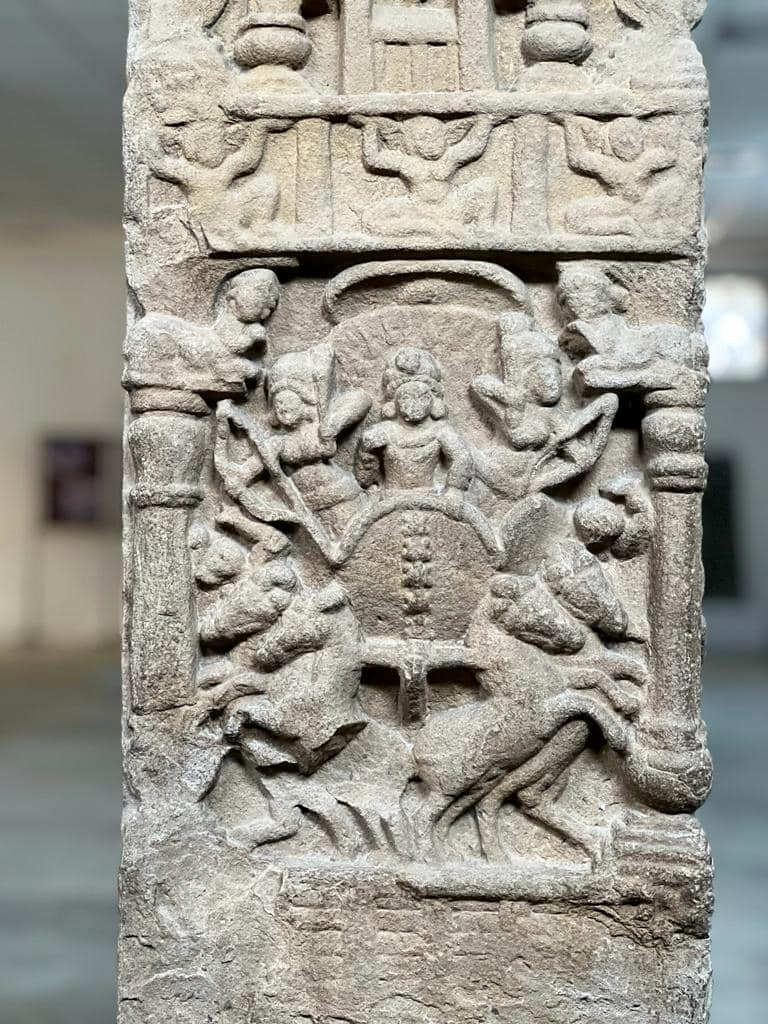What could this carving be? - This is a stone carving found in the Archeology Museum of Bodh Gaya. This is located around the Jaya Sri Maha Bodhi in Bodhgaya BC. In the ancient sand stone railing, which is believed to belong to the 2nd century. The garage fence was removed from its original location and has now been installed in the Bodhgaya Archaeological Museum.
In this stone fence, as well as in the Garadi fence of Bharhut, there are carvings created in a Buddhist iconography, including various stages of the Buddha's character, Bodhisattvas and Jataka story events. This carving is set as the second carving from the top of a stone pillar at the south-west corner of this sandstone garadi fence. This museum has given the imagery here as a representation of the 'Sun' god. In the history of Indian art, it has been mentioned in such a way that this is the 'oldest stone carving of Sun God in human form'.
Even though 'Sun' has been presented symbolically in various ways in pre- and early history as well as in Vedic literature, in Hindu iconography, 'Sun God' is clearly identified with anthropomorphic traits. It is the opinion of many Indian art historians that it is from around the 5th century. With anthropomorphic features, the iconography of the sun god is commonly depicted in Indian literary sources as 'holding a lotus flower in each of his hands, standing in a one-wheeled chariot with seven horses driven by a charioteer named Aruna'. Also, the solar halo is often shown behind the head. But this carving on the Great Bodhi Garadi fence of the Buddha shows a chariot with 'four horses' and the rider does not have a lotus in his hand or a solar halo behind his head. There is no driver in it and the person in front is shown driving the vehicle. It is also shown that two people on either side of him are trying to shoot the two people below with bows and arrows. Also, if this shows the 'Sun God', this carving is more likely to be applied to the east side of the Garadi fence, but it is found in the southwest. Although a 'divine son' (Suriya Devaputto) named 'Suriya' is found in the Sutras during the early Buddhist period, there is no such image of the Sun God riding on a car with seven seats in Buddhist literary sources. The carvings of this garadi fence are almost entirely presented in a Buddhist context.
Also, another stone carving with this image is found on the wall of the Buddhist cave complex called 'Bhaja' in Pune, India. (It is given as the first comment.) Indian art historians consider this to be a representation of the sun god himself. This cave temple was also built in BC. It is considered to belong to the 2nd century. There, four horses are used for the chariot. It shows a charioteer with two women, neither lotus flowers in his hands nor solar panels behind. One woman is pregnant. The main male figure in the royal lila is driving the chariot and above him is the jatra. It shows the car running over someone. It seems that the event depicted in the Bodh Gaya Garadi fence is given in more detail. This is contemporaneous with the carvings at Bodhgaya and found in a Buddhist context. It also does not show all the characteristics of the sun god shown in Hindu mythology, especially 'seven horses', 'carrying lotus flowers with both hands', 'Aruna Ratchacharya' or 'Surya Prabhamandala' etc. are not found here either.
When the above facts are examined moderately, a reasonable doubt arises as to whether this carving can really be a representation of the 'Sun God' as indicated by the Bodh Gaya Museum. Could it not be a representation of a Buddhist Jataka story or an event associated with Buddhism or a contemporary event that was well-known at that time? B.C. for Jaya Sri Maha Bodhi of Bodhgaya, which is considered to be the first among Sambuddha's customer temples. What could be really depicted in this carving on the stone garadi fence, built as far back as the 2nd century?

#blurt #blurtstory #geekpranee #carving #art #libary #life #fire
Authors get paid when people like you upvote their post.
If you enjoyed what you read here, create your account today and start earning FREE BLURT!
If you enjoyed what you read here, create your account today and start earning FREE BLURT!